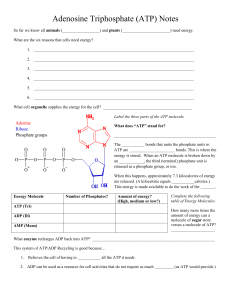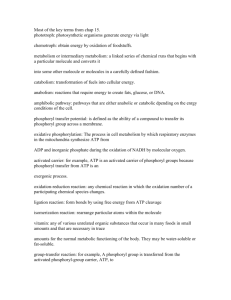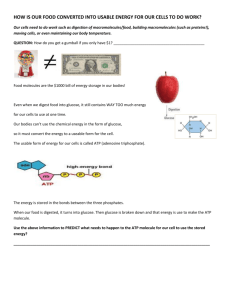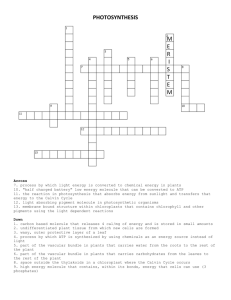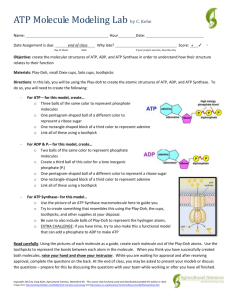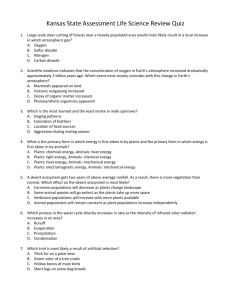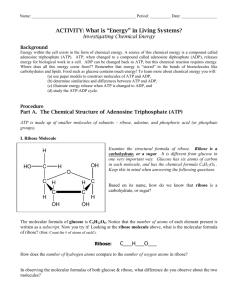Name ATP: Cell Energy Introduction Energy within a cell exists in
advertisement
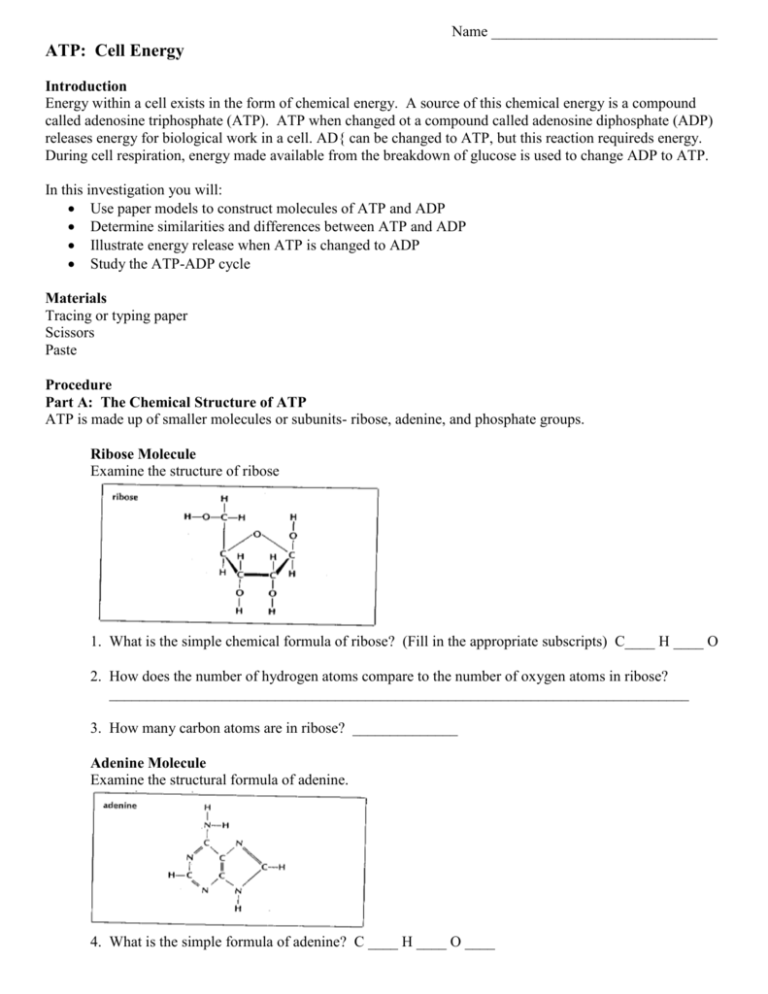
Name ______________________________
ATP: Cell Energy
Introduction
Energy within a cell exists in the form of chemical energy. A source of this chemical energy is a compound
called adenosine triphosphate (ATP). ATP when changed ot a compound called adenosine diphosphate (ADP)
releases energy for biological work in a cell. AD{ can be changed to ATP, but this reaction requireds energy.
During cell respiration, energy made available from the breakdown of glucose is used to change ADP to ATP.
In this investigation you will:
Use paper models to construct molecules of ATP and ADP
Determine similarities and differences between ATP and ADP
Illustrate energy release when ATP is changed to ADP
Study the ATP-ADP cycle
Materials
Tracing or typing paper
Scissors
Paste
Procedure
Part A: The Chemical Structure of ATP
ATP is made up of smaller molecules or subunits- ribose, adenine, and phosphate groups.
Ribose Molecule
Examine the structure of ribose
1. What is the simple chemical formula of ribose? (Fill in the appropriate subscripts) C____ H ____ O
2. How does the number of hydrogen atoms compare to the number of oxygen atoms in ribose?
_____________________________________________________________________________
3. How many carbon atoms are in ribose? ______________
Adenine Molecule
Examine the structural formula of adenine.
4. What is the simple formula of adenine? C ____ H ____ O ____
5. What element is in adenine that is not in carbohydrates? ______________________
6. What element is in carbohydrates that is not in adenine? ______________________
Phosphoric Acid
Examine the structural formula of phosphoric acid. It is much like the phosphate groups in ATP.
7. What is the simple chemical formula of a phosphate group H ____ P ____ O ____
8. What does the prefix tri- in triphosphate mean? _________________________________________
Constructing an ATP Molecule
An ATP molecule is made up of one ribose, on adenine, and three phosphate groups joined.
Cut out the models of adenine, ribose, and phosphoric acid. Cut along solid lines only.
Attempt to join the adenine and ribose molecules much as you would pieces of a puzzle.
9. What end parts must first be removed from each molecule in order for adenine and ribose to fit
together? _______________________________________________________________________
10. What molecule is formed from the parts that are removed? _______________________________
Examine the phosphoric acid models.
Attach one of the three phosphates to the ribose molecule by removing an H from the phosphoric acid
molecule.
Attach the remaining phosphoric acid molecules one at a time to the phosphate group already attached to
ribose.
11. What did you remove to make these connections? ______________________________________
12. List the five building blocks of one ATP molecule. _____________________________________
You have now built an ATP molecule.
13. What is required for the chemical combination of these parts? (HINT: see introduction)
_____________________________
Part B. Gaining Energy from ATP as It Changes to ADP
Remove one phosphate group from the end of your ATP model.
14. How many phosphate groups are still attached to the original molecule? __________________
15. This new compound with one fewer phosphate groups than before is called ADP. What does the prefix
di- mean? _________________________
16. List the four building blocks that are needed to form one ADP molecule.
___________________________________________________________________________________
17. Explain how an ATP molecule is changed to an ADP molecule. _______________________________
___________________________________________________________________________________
18. What is released when ATP is changed to ADP? ___________________________________________
Part C. Changing ADP to ATP
ATP can be formed within living organisms if the correct raw materials are available. These raw materials are
ADP, phosphoric acid, and energy. We can again use models to help show how ATP is formed.
Construct an ADP molecule.
Attach a phosphoric acid molecule to the ADP model. If necessary, remove any H or OH ends to
provide the point of attachment. This combination forms an ATP molecule.
19. What is the process of adding phosphate groups to ADP called? ______________________________
Analysis
20. List the name and number of each molecule forming ATP.
___________________________________________________________________________________
21. List the name and number of each molecule forming ADP.
___________________________________________________________________________________
22. How do ADP and ADP differ in
a. number of phosphate groups? ______________________________________
b. number of ribose molecules? _______________________________________
c. number of adenine molecules? ______________________________________
23. Your muscles require energy to move your body. What chemical directly supplies your muscles with
energy? _______________________
24. What process directly supplies your body with the energy it needs to change ADP back to ATP?
_____________________________
25. What organelle is responsible for the conversion of glucose to ATP? __________________________


